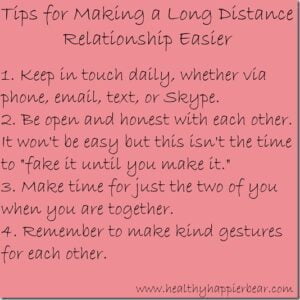Long Distance Friendship Vs Geographically Close Relationship
Long distance friendships require more effort to maintain, while geographically close relationships offer regular interaction and support. Both have their own challenges and rewards, creating unique dynamics in each situation.
Long distance friendships often rely on virtual communication and occasional visits, fostering deep emotional connections despite the distance. On the other hand, geographically close relationships provide more opportunities for physical closeness and regular face-to-face interactions, leading to a deeper understanding of each other’s daily lives.
Understanding the dynamics of both types of relationships can help individuals navigate the challenges and appreciate the strengths that each one offers.

The Impact Of Distance On Relationships
When it comes to relationships, whether it’s a friendship or a romantic relationship, the impact of distance cannot be overlooked. Both long-distance friendships and geographically close relationships present their unique set of challenges and adjustments that individuals have to navigate through. Understanding the impact of distance on relationships is crucial in maintaining and nurturing meaningful connections.
Unique Challenges Of Long Distance Friendships
Long distance friendships often face challenges that are distinct from close geographical relationships. The physical separation makes it difficult to engage in regular face-to-face interactions. This absence of physical presence can lead to feelings of loneliness and a sense of missing out on shared experiences. Additionally, time zone differences can create communication barriers, making it challenging to find convenient times to connect.
Adjustments In Close Geographical Relationships
In contrast, geographically close relationships may need to adjust to the expectation of more frequent in-person interactions. Proximity can sometimes lead to an assumption of constant availability, potentially making it challenging to set boundaries or find personal space. On the flip side, physical closeness can also provide opportunities for spontaneous meetups and activities, fostering a deeper sense of connection through shared experiences.
Communication And Connection
When it comes to maintaining meaningful relationships, communication and connection play a vital role. Whether it’s a long-distance friendship or a geographically close relationship, staying in touch and fostering a strong connection is essential for building and sustaining bonds.
Utilizing Technology For Long-distance Friendships
Long-distance friendships often heavily rely on technology to bridge the gap across miles. With the advent of various communication tools, maintaining connections across long distances has become more manageable. Video calls, instant messaging, and social media platforms enable friends separated by geographical barriers to stay updated with each other’s lives, share experiences, and offer emotional support. Moreover, virtual activities such as online gaming or streaming movies together can create a sense of togetherness despite the physical separation.
Frequency Of Interactions In Geographically Close Relationships
Geographically close relationships benefit from being able to interact frequently in person. The proximity allows for regular outings, shared activities, and face-to-face interactions that strengthen the bond between friends. Whether it’s grabbing a meal, attending events together, or simply hanging out, the ability to spend time in each other’s physical presence fosters a deeper connection and understanding. Additionally, being in close proximity enables friends to offer immediate support during times of need, creating a stronger sense of reliability and dependability in the relationship.
Emotional Support And Understanding
When it comes to emotional support and understanding, both long distance friendships and geographically close relationships play a crucial role in providing comfort, empathy, and connection. Whether separated by miles or living in close proximity, the ability to build trust and nurture emotional connections significantly impacts the depth and quality of the relationships.
Building Trust And Empathy In Long Distance Friendships
In long distance friendships, the foundation of trust and empathy is often built through consistent communication and active listening. Despite the physical distance, developing trust requires open and honest conversations, transparency, and reliability. Through virtual platforms and technology, friends can share their experiences, fears, and aspirations, creating a sense of mutual understanding and empathy. Empathy in long distance friendships grows from the willingness to step into each other’s shoes and genuinely care about the emotional well-being of the other person. By offering support from a distance, friends can strengthen their connection and foster a deep sense of trust and understanding.
Nurturing Emotional Connection In Geographically Close Relationships
In geographically close relationships, nurturing emotional connections is often based on regular face-to-face interactions and shared experiences. Being physically present allows for non-verbal communication, such as body language and facial expressions, which can deepen emotional connections. Emotionally supportive gestures, like a comforting hug or a reassuring touch, can play a significant role in conveying understanding and empathy. The proximity also allows for spontaneous support and the opportunity to create shared memories, which can further strengthen the emotional bond between individuals in close relationships.
Maintaining Trust And Commitment
Maintaining trust and commitment in long-distance friendships and geographically close relationships requires open communication, understanding, and effort from both parties. While distance may pose challenges, it can strengthen bonds through shared experiences and meaningful conversations. Both types of relationships require dedication to nurture and sustain mutual trust and commitment.
Long Term Trust-building In Long-distance Friendships
Trust is the cornerstone of any friendship, and in long-distance relationships, it takes time and effort to build and maintain this trust. Consistent communication becomes the linchpin in forming a strong foundation of trust. Friends who are physically separated must rely on various means of communication, such as video calls, texts, and phone calls, to stay connected.
- Regular and open communication helps in fostering trust.
- Consistency in following through with promises and plans strengthens trust over time.
- Sharing experiences and being emotionally present for each other contributes to mutual trust.
In a long-distance friendship, trust is often tested by the absence of physical proximity. However, consistent efforts and genuine communication can lead to the establishment of a long-term, “distance-proof” trust between friends.
Staying Committed In Geographically Close Relationships
While physical proximity might seem to simplify maintaining commitment in geographically close relationships, it also comes with its own set of challenges. Quality time and effective communication play a pivotal role in staying committed to each other in close proximity.
- Scheduling regular date nights or activities where both partners can connect on a deeper level.
- Open and honest conversations about feelings and expectations contribute to continued commitment.
- Respecting boundaries and individual space while actively engaging with each other strengthens the bond.
In a geographically close relationship, the challenge lies in nurturing the commitment to each other amidst the distractions of daily life.
Physical Presence And Shared Experiences
When it comes to forming and maintaining meaningful connections, physical presence and shared experiences play a pivotal role. Whether it’s through the screen or face-to-face, the dynamics of long-distance friendships and geographically close relationships are influenced by the tangible aspect of being together.
Overcoming The Absence Of Physical Presence In Long Distance Friendships
Long-distance friendships often face the challenge of physical separation, making it difficult to be present for important moments in each other’s lives. However, with the advancement of technology, staying connected has become more manageable. Platforms like video calls, instant messaging, and social media bridge the gap, enabling friends to interact and share their lives despite the miles between them. Taking advantage of these tools helps nurture the relationship, validate emotions, and create enduring bonds despite the absence of physical proximity.
Shared Activities And Experiences In Geographically Close Relationships
Geographically close relationships benefit from the ease of shared activities and experiences due to physical proximity. Whether it’s grabbing a coffee, going for a hike, or attending events together, the ability to engage in these shared experiences effortlessly creates a strong sense of togetherness. These shared activities not only deepen the connection but also provide a foundation for lasting memories, strengthening the bond between friends or partners.
Frequently Asked Questions For Long Distance Friendship Vs Geographically Close Relationship
What Are The Pros Of A Long-distance Friendship?
Long-distance friendships allow for personal growth, independence, and diverse cultural experiences.
How Can Geographically Close Relationships Benefit Individuals?
Geographically close relationships provide physical presence, increased intimacy, and more frequent face-to-face interactions.
What Are The Challenges Of Maintaining A Long-distance Friendship?
Challenges of long-distance friendships include communication barriers, potential feelings of loneliness, and differing time zones.
What Are The Common Activities For Geographically Close Couples?
Geographically close couples can enjoy activities such as spontaneous outings, physical touch, and shared domestic routines.
Can Technology Help In Maintaining Long-distance Friendships?
Yes, technology aids in maintaining long-distance friendships through video calls, instant messaging, and social media platforms.
How Can Individuals Maintain Balance In Both Types Of Relationships?
Maintain balance by prioritising communication, scheduling visits, and being open and honest about emotional needs.
Conclusion
In the end, the type of relationship that works best for you depends on your individual circumstances. Whether it’s a long-distance friendship or a geographically close relationship, both have their advantages and challenges. Finding a balance that meets your needs and brings happiness and fulfillment is key.
Keep communication open and prioritize maintaining a strong connection with your loved ones, regardless of the distance.






